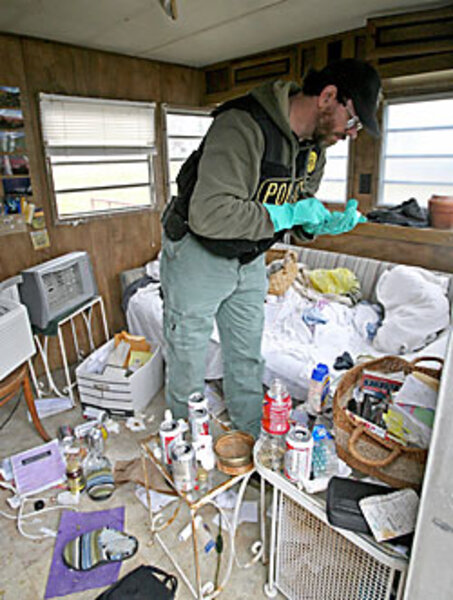New worries about meth trends
Loading...
After a dramatic decline over several years, the availability of methamphetamine – a highly addictive stimulant "cooked" with chemicals from over-the-counter cold medications – began to creep up in 2008.
The reversal, reported by the National Drug Intelligence Center (NDIC), worries law enforcement agencies. They've poured resources into treating an epidemic that crossed the country in recent years. Over 17,000 methamphetamine labs were discovered in 2004, tucked inside homes, barns, and vehicles. Among the dangerous byproducts: toxic waste, explosions, theft, and other crimes to support addiction.
"It's everywhere from soccer moms to someone who just got out of prison," says Sgt. Gary Higginbotham of the Jefferson County, Mo., sheriff's department, which led the nation in lab busts for the past several years.
In 2005, Congress passed restrictions on key ingredients ephedrine and pseudoephedrine found in cold and allergy medicines. It helped: during 2007, agents found just 5,910 labs. That year, Mexico banned all imports containing either chemical in an effort to curb exports by large-scale traffickers. The move helped create methamphetamine shortages in many parts of the country during 2007 and the first part of 2008, the NDIC states in its December report.
But several indicators suggest that since then, domestic production has increased to fill the void. Authorities say more small-time cooks are sidestepping federal regulations to obtain what they need to manufacture the drug.
The per-gram price of pure methamphetamine fell more than 30 percent, from $267.74 to $184.09, between the last quarter of 2007 and the third quarter of this year, according to the US Drug Enforcement Administration (DEA).
Lab seizures also quickened in many areas. In Michigan, for example, 127 sites were raided between January and July of 2008 after 101 of them turned up in all of 2007.
"Restrictions did their job for a while, but [methamphetamine producers] found a way to get around them," said Abraham Azzam, executive director of Michigan's High Intensity Drug Trafficking Area, a federal program that coordinates drug enforcement. "What we're seeing is a proliferation."
As a result of the federal restrictions passed in 2005, there are daily and monthly limits on how many grams of ephedrine-based products may be purchased. Employees check customers' identification and log the amounts into a store or chain-wide database to ensure compliance.
That law is now commonly bypassed through a technique called "smurfing." Small groups who know two or three cooks will travel from store to store, buying the maximum allowable amount of ingredients. Then they trade medications for finished methamphetamine or cash.
Sergeant Higginbotham says smurfing is particularly effective because different companies' databases aren't usually linked – Walgreen's can't tell if someone just finished buying suspicious amounts of ephedrine at Target. And the profit is enormous: local smurfers are paid $50 for a $9 box of medication.
Sparsely populated Jefferson County hasn't experienced the same decline in lab seizures as other areas. Two hundred facilities were uncovered there in 2008. And while that's 50 fewer than a few years ago, it's still a very large number compared with the 359 seizures in all of Illinois in the same year.
One factor might be that other agencies – less sensitive to the problem of smurfing than Jefferson County, didn't put the same resources into searching. "A lot of people weren't looking in the right places," Higginbotham says.
But it's not just small meth operations that are more active. Some larger producers south of the US border began to relocate here following the severe import restrictions announced by Mexico in 2007. Labs run by Mexican drug traffickers have trickled back into California's Central Valley, a mostly rural region that pumps large batches of methamphetamine to major cities for distribution.
"We're not surprised because we always realized it was a possibility it would return to this area," says Gordon Taylor, special agent in charge of the DEA field office in Fresno, Calif.
The valley hasn't seen more "superlabs," or facilities with capacities of at least 10 pounds per cooking cycle, Mr. Taylor says. Five such labs were seized in 2007, compared with four in 2008. But at one superlab bust in February, agents discovered evidence of smurfing on a very large scale. Abundant packaging from different types and brands of cold medication dotted a Stevenson, Calif., house where glassware suggested a remarkable 44 pounds of methamphetamine were churned out every day or two.
The most notable increase in the drug's production occurred among medium-sized labs producing 2 to 9 pounds per cooking cycle, Taylor says. Agents in his area found four in 2008 after turning up none in 2007.
The NDIC report projects these trends – more and larger-scale smurfing operations, more small-time labs, and more labs moving north from Mexico – to continue pushing up meth production. It also warns of Mexican producers circumventing import restrictions by smuggling ingredients from legal sources in South America. And it notes that an increasing amount of Ecstasy, another illegal stimulant, is being made with meth to make it more addictive.





